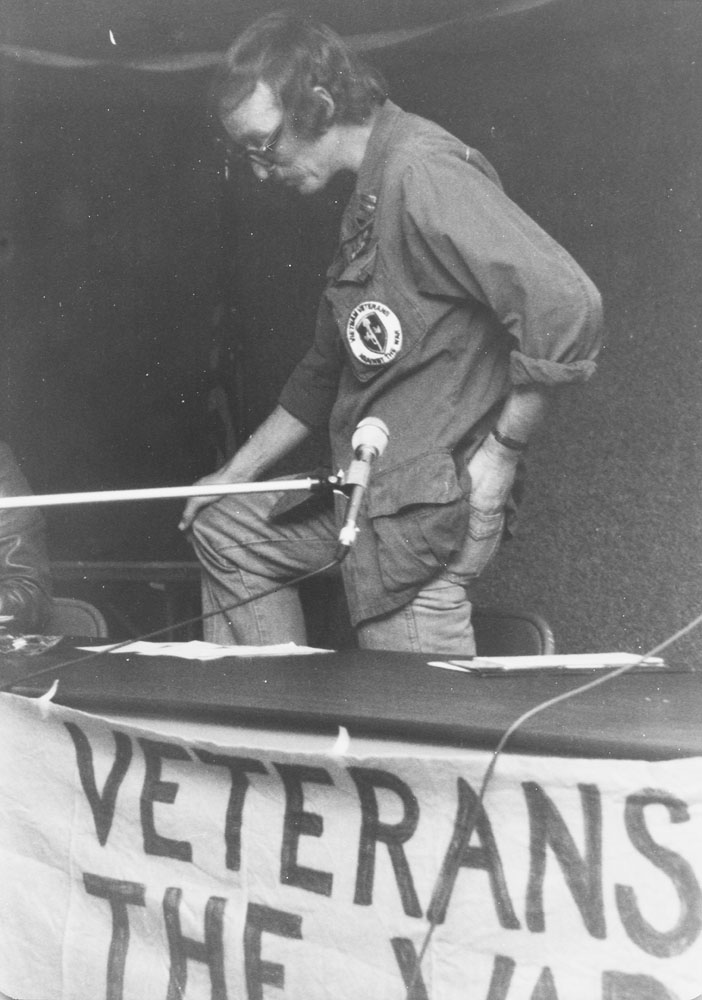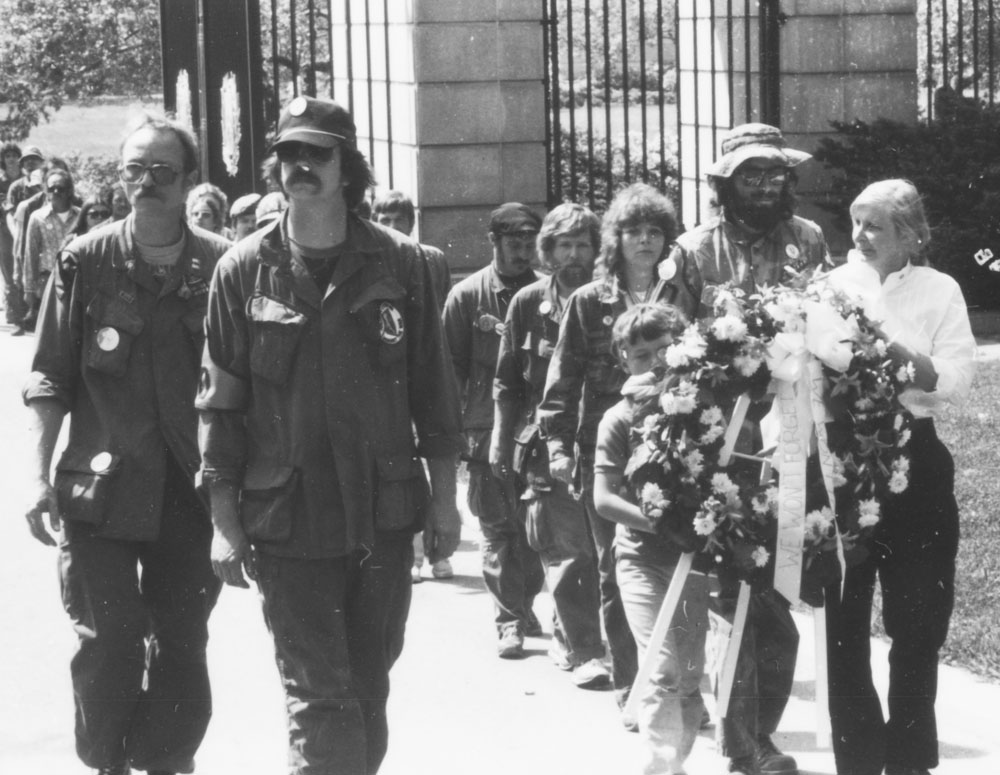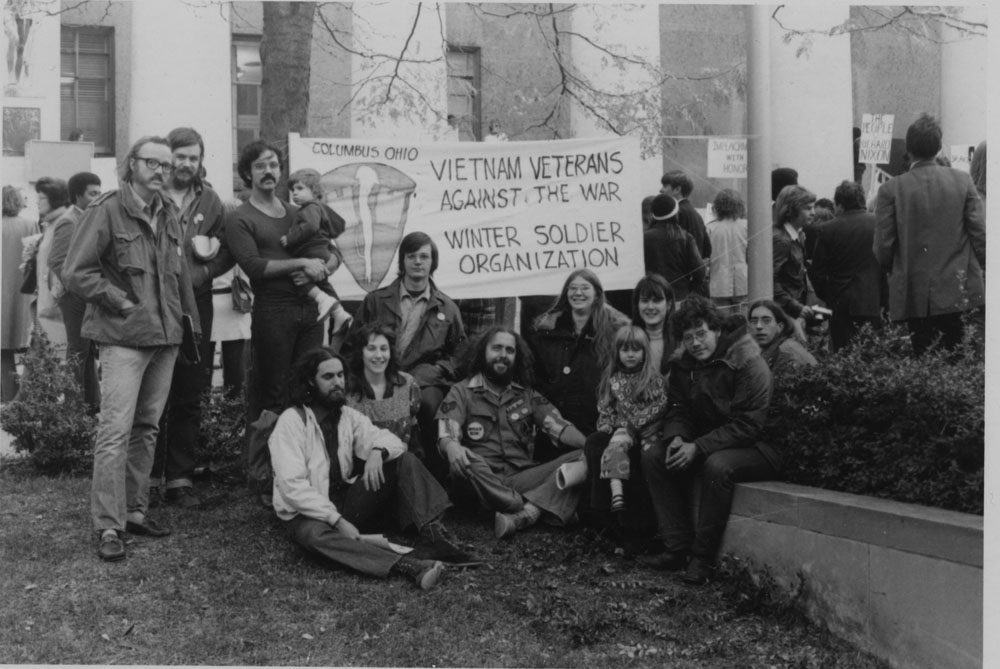 |
Life in the VVAW National OfficeBy Pete ZastrowI got back from Vietnam at the end of 1969. I connected with VVAW in 1970. My home was Ft. Thomas, Kentucky and I belonged to the Cincinnati VVAW chapter and eventually became the Coordinator for what we called MOINKWVAPA, which was Michigan, Ohio, Indiana, West Virginia, Pennsylvania. I don't remember all of them. I started working on the paper when I came to Chicago after being elected to the National Office in 1973. I moved into the VVAW Collective house at 827 Newport. We all did newspaper. We had meetings and decided who was going to write what. Sam Schorr was our layout expert at the time. There wasn't a lot of "everything else" because we wrote the articles and then two of us, mostly, typed them and gave them to Sam, and he put them together. He did all of the, what do you call it, whatever work it's called when you make up the page. I think I replaced Barry Romo. He left to go work on the Gary Lawton case. I replaced him and he came back the next year or year after. I put out our local, chapter wide, newsletter in Cincinnati, which was some of the same thing; Rah, Rah VVAW, and here's what we did, and here why we we're heroes for doing it.
It was Mimeographed, but towards the end of time I spent in Cincinnati a young man who came and lived in our basement had been brought up as a printer, so he found out that his school in North Carolina was selling its printing press. Anyhow, we bought it. We went down and got it. It was this funny printing press that printed 24 by something or other. It was originally intended for blueprints. So, we started doing our own newspaper. In the basement! By the time I got to the National Office, I already knew how the process went, more or less. It wasn't a mystery. I was surrounded by people who were already doing it. So that made it even easier. We divided tasks in the National Office. Marla Watson and I did all the prison writing, which was a huge amount of letters. We put out a newsletter to prisoners every month. Ed Damato and I think, Brian Adams, at the time would have been doing the corresponding with chapters. There was always something in chapter news that we figured was publishable in the newspaper. We would have, usually, some kind of prison column, which either Marla or I would write. Yes. I think we had 300 prisoners, at one point, all around the country. Most of them, not all of them, were veterans. We got at least tangentially involved in a number of the prison fights that were going on. There was a group in Oklahoma, I can't remember. We were writing to people in prisons, pretty much all across the country. We had a Gestetner which we did the prison newsletter on. You just put a ream of paper in the Gestetner and it prints it out. We sent out 300-400 of them. I have no idea if they still exist. Marla was kind of our in-house secretary. I know she had a log of all the mail that came in, each individual letter and to whom it went to be responded to. We had an addressing machine. There were little metal plates. You typed out the address on the plates, and you put that in a machine and then you ran the envelopes, for 8 x 10 envelopes through the machine and it would print the addresses, in zip code order. Because we would then take them to the Post Office and did bulk mailings with them. Mostly the paper went to the chapters. I distinctly remember our late-night trips down to the Greyhound station with boxes, and boxes, and boxes to send out to chapters. We would ship them via Greyhound and they would just pick them up at the different location. At one point, we had UPS come and collect them from our garage in the back of 827 Newport. I don't remember why we stopped doing that. But we went from there to the Greyhound. Maybe it was quicker on Greyhound. I'm not sure where the boxes came from. I remember working out in the garage for hours at a time putting a hundred in this one and two hundred in that one and so forth. Anything less than, I think it was 50, we would send through the mail. There was a Greyhound bulk shipping corner in their downtown office, at that time. We would take the boxes in. They would weigh them and I assume Sam would give them a check for whatever it came out to. Greyhound was considered a perfectly reliable way to get things in bulk around the country. They would just leave them at the individual stations and the chapter representative, or whoever, would go pick them up and them distribute them. I can't remember ever picking them up in Cincinnati, but I must have. It was printed in Palos Heights. Palos Printers. It had already been going there for some time before I came to Chicago. It was a long trip down there. We all loved the opportunity to go down and turn the paper. Because, then, Sam Schorr would let us have dinner out. And actually, paid for dinner. Of course, we never got to do that normally, because we didn't have enough money to go out and pay for dinner. But that was our one treat. Take the paper to Palos Heights and you could have dinner out. Brian Adams's girlfriend, Carol, was a waitress in a local restaurant, and used to come home back to the office, at night after working, and count out her tips, which weren't very much. She was our artist and did all the posters. I still have framed versions of some of them. Not signing articles was more of a collective thing. We weren't in hiding. We were not an underground collective someplace. We were quite public. I think it was just; "It is a collective effort. Here are the articles. And they are not by individuals." Even though they were by individuals. Around the late 1980s, we started signing some articles. In 1974-75, I remember doing a series of articles about the Bonus March, even actually doing research. Someone had given us a copy of the Communist Party version of the Bonus March. It gave us a lot more information than we could get out of normal history books. I don't recall that I ever signed any of those. I think there were a number of them. I like to think there were four of them. I don't remember anything about the name change from Winter Soldier to The Veteran. There must have been major discussions. There was, of course, a remarkable amount of discussion about getting rid of WSO (Winter Soldier Organization). Were we really just a veteran's organization or did we really want to take on the rest of the world? Obviously, the veterans organization won that discussion. That's probably the same time we never even thought about keeping the Winter Soldier and automatically changed it to The Veteran. While the war was still going on, we would put out a fund-raising letter, actually with the help of a fund-raising company in New York. After that went out, within the next couple of weeks, the mailman would bring us bags of mail. All of which was money! You know, mostly five and ten dollars.Sometimes there were the people who would give us a lot. We wrote a letter and then the company sent it out. I think they had all the various Peace Groups names. They would mail out, like a hundred thousand. I remember they were very happy with us because we had a five percent return. That was remarkable for one of their mailings. Remarkably high. Someplace, in one of our files, there is a letter that was written by people in Poughkeepsie New York, who gave us $10,000, which was a lot of money back then. They had written to ten of their friends, saying "We've given this money to this worthy organization. We think you should do the same." It kept us going for a while. In the time that I was there, at Newport, I can remember three of them. I think. But, after the war was over, raising money became much more of a problem. The last issue of Winter Soldier was June-July 1975. And then there is no issue of the paper until October of 1975. At that point, it is The Veteran. I think we moved in between there to 7719 South Fielding in Chicago. It was an old house, which at one point had enclosed five or six apartments. But it was vacant. It had, something like, twelve rooms. The lot next door was just a vacant lot, used by the locals to chop up the cars they stole. It was not what you would call a beautiful, suburban housing. We were there for years. And, it was cheap. The money was certainly less. I don't remember ever discussing the newspaper color going away. I can vaguely recall some discussions at various times with the Winter Soldier about what color should we be this month. But I don't think that was ever a serious discussion. Brian moved out. He didn't make the move with us to the South Side of Chicago. I think Bill Davis may have replaced him. We all did the same sort of thing. Ed Damato was famous for having an article that was supposed to be done today and he would be in the kitchen polishing the toaster. This is something that my family still uses, when you're putting off doing what you don't want to do. You're polishing the toaster. He always got it done. But he would put it off as long as possible. VVAW putting out a newspaper was a way to communicate with our chapters. It was also a way to get forth a point of view. As you might guess, on the South Side of Chicago, our neighbors were all African American. At one point, we talked a bunch of kids into going around and selling the paper in the neighborhood. There is a picture of them, on the front page of an issue of The Veteran, someplace along the way there, sitting on our front porch. I think there were six or eight of them. They went out into the neighborhood and sold the paper. I think it was a quarter, in those days. We gave them five cents each for selling it. Five cents per paper. Nobody got rich. We would go places, like the local college, which at that point was Kennedy King. It probably has a new name now. At least a couple of us went there as students on the GI Bill. We would sell the paper there, or hand it out. I would do the same thing at the Post Office. I'm sure Barry Romo did too. We had big, big discussions, I remember, about "should we change from Vietnam Veterans Against THE War or just Vietnam Veterans Against War." The "the War" obviously won out. You have to keep in mind that there were four, six, eight people, living together, doing everything together. A lot of it, was just talking. So, we could afford these lengthy discussions about something of relatively minor importance, that we would then discuss for hours. And then, we would take it to a National Meeting where it could be discussed for some more hours. Marla and I were the two typists in the crew. I think Ed Damato was a typist too, although I'm not sure he was quite as good as the others. Mostly it was a case of "could you type fast enough." We all took notes at these National Meetings. Of course, we then had to discuss what was said. We had to make sure that everybody agreed that this is what the point of that particular discussion was, if it had any point. Then the collective living started to end. Barry moved on, Ed was back to New York, Bill Davis moved. I think I was the last one, the last person standing at the Fielding address. I think it would have been, maybe, 1980, I moved to an apartment on Farragut, on the North Side of Chicago, in the area where I delivered mail. And besides that, my girlfriend at the time, was on the second floor, and I was on the third floor. We moved most of the stuff, the files and so forth from Fielding to the third floor on Farragut. We had an extra body, whose name was Lee Channing. He lived on the third floor, in my apartment, while I lived with my now wife, on the second floor. And Lee kind of took care of what there was in terms of the office. Chapter reports, chapter information, was about all that was left, in terms of activities. We would do our normal Veterans Day and Memorial Day things, occasional forays to the VA. But there wasn't a whole lot left at that point. It was the end of the National Office Collective. All that was really left was kind of a mailing address. I can't recall what we were doing about the paper in those days. By 1983, I know I had become a father and was working, not only at the Post Office, but another job on top of that. I was not doing much about VVAW. I was aware of what was going on. It's not like it was unfriendly. It's just, there are just so many hours in a day. If someone had said we need an article on something or the other, I would no doubt have done it. Writing articles was never that difficult for me. But I don't remember. When I look back, any of us who had families and who were trying to keep families together, and work, and make enough money to survive, that was a full-time job. While we would do what we could, in terms of VVAW work; I remember putting on a fairly major role at the 20th Anniversary affair, in a church on the North Side. A lot of it, we couldn't do. You could either take care of your family, or you could take care of VVAW. People who really kept things going, like Bill Branson and his wife, didn't have family, could spend a lot more energy on this. What can I say? Times change. I used to do a lot of the picture taking, the photographs. We had a darkroom in a little room in the basement of the house on Fielding. I would develop all our film. One of the boys in the neighborhood got all intrigued by it. He used to come over and help wrap the film around the, whatever it was called, so it could get developed evenly. He was much better at it than I was. Unfortunately, I'm afraid that is the kind of talent which became sort of outmoded fairly quickly. So, I would do the pictures, take them down to our lab and develop them. People would make contact sheets. People would decide "oh, this is a good one. Let's use it" and so forth. It is still important for VVAW to have a paper today. The paper is something entirely different now. I think it serves a need. I read it religiously. I even pass it along. Pete Zastrow is a long time VVAW member and former VVAW National Coordinator.
|




